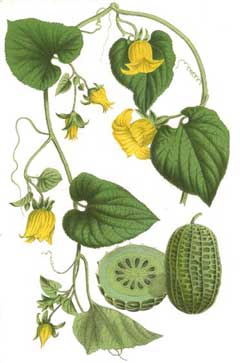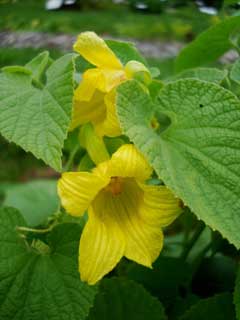 |
|
www.flickr.com/photos/stadtkatze |
 |
| http://commons.wikimedia.org/wiki/File:Thladiantha_dubia.jpg |
Translate this page:
Summary
Physical Characteristics

 Thladiantha dubia is a PERENNIAL CLIMBER growing to 2 m (6ft 7in) at a fast rate.
Thladiantha dubia is a PERENNIAL CLIMBER growing to 2 m (6ft 7in) at a fast rate.
See above for USDA hardiness. It is hardy to UK zone 7. It is in flower from July to August, and the seeds ripen from September to October. The species is dioecious (individual flowers are either male or female, but only one sex is to be found on any one plant so both male and female plants must be grown if seed is required). and is pollinated by Insects. The plant is not self-fertile.
Suitable for: light (sandy), medium (loamy) and heavy (clay) soils and prefers well-drained soil. Suitable pH: mildly acid, neutral and basic (mildly alkaline) soils. It cannot grow in the shade. It prefers moist soil.
UK Hardiness Map
US Hardiness Map
Synonyms
Plant Habitats
Cultivated Beds;
Edible Uses
Edible Parts: Fruit Leaves Root
Edible Uses:
Fruit - raw or cooked. Succulent[2, 177]. The oblong fruit is about 4cm long and 2.5cm wide[200]. Young plant - cooked[105, 178]. Root[178]. No further details are given.
References More on Edible Uses
Medicinal Uses
Plants For A Future can not take any responsibility for any adverse effects from the use of plants. Always seek advice from a professional before using a plant medicinally.
Alterative Astringent Cardiotonic Cholagogue Diuretic Galactogogue
The seed is a cardiac tonic and an astringent[178, 218]. The root is alterative, cholagogue, diuretic and galactogogue[178, 218].
References More on Medicinal Uses
The Bookshop: Edible Plant Books
Our Latest books on Perennial Plants For Food Forests and Permaculture Gardens in paperback or digital formats.

Edible Tropical Plants
Food Forest Plants for Hotter Conditions: 250+ Plants For Tropical Food Forests & Permaculture Gardens.
More

Edible Temperate Plants
Plants for Your Food Forest: 500 Plants for Temperate Food Forests & Permaculture Gardens.
More

More Books
PFAF have eight books available in paperback and digital formats. Browse the shop for more information.
Shop Now
Other Uses
References More on Other Uses
Cultivation details
Succeeds in almost any soil that is well-drained[1, 200]. Prefers a fertile soil in a sunny but sheltered position[188]. Hardy to about -20°c[187]. Although the plant is hardy, it grows better on a sunny wall[1]. A fast-growing plant, climbing by means of tendrils[188]. It grows well on fences etc and can be used as a screen over unsightly objects, though it dies back to the roots each winter[233]. The young shoots require protection (the report does not specify from what)[187]. Dioecious. Male and female plants must be grown if fruit and seed is required.
References Carbon Farming Information and Carbon Sequestration Information
Temperature Converter
Type a value in the Celsius field to convert the value to Fahrenheit:
Fahrenheit:
The PFAF Bookshop
Plants For A Future have a number of books available in paperback and digital form. Book titles include Edible Plants, Edible Perennials, Edible Trees,Edible Shrubs, Woodland Gardening, and Temperate Food Forest Plants. Our new book is Food Forest Plants For Hotter Conditions (Tropical and Sub-Tropical).
Shop Now
Plant Propagation
Seed - sow spring in a greenhouse[K]. When they are large enough to handle, prick the seedlings out into individual pots of fairly rich soil and plant them out after the last expected frosts. Division of tubers in spring or autumn. The tubers can be harvested in the autumn and stored in a cool frost-free place overwinter then planted out in the spring[K].
Other Names
If available other names are mentioned here
Native Range
TEMPERATE ASIA: China (Gansu Sheng, Hebei Sheng, Heilongjiang Sheng, Jilin Sheng, Liaoning Sheng, Ningxia Huizi Zizhiqu, Shaanxi Sheng, Shandong Sheng, Shanxi Sheng, Sichuan Sheng (north)), Korea
Weed Potential
Right plant wrong place. We are currently updating this section.
Please note that a plant may be invasive in one area but may not in your area so it's worth checking.
Conservation Status
IUCN Red List of Threatened Plants Status :

Growth: S = slow M = medium F = fast. Soil: L = light (sandy) M = medium H = heavy (clay). pH: A = acid N = neutral B = basic (alkaline). Shade: F = full shade S = semi-shade N = no shade. Moisture: D = dry M = Moist We = wet Wa = water.
Now available:
Food Forest Plants for Mediterranean Conditions
350+ Perennial Plants For Mediterranean and Drier Food Forests and Permaculture Gardens.
[Paperback and eBook]
This is the third in Plants For A Future's series of plant guides for food forests tailored to
specific climate zones. Following volumes on temperate and tropical ecosystems, this book focuses
on species suited to Mediterranean conditions—regions with hot, dry summers and cool, wet winters,
often facing the added challenge of climate change.
Read More
Expert comment
Author
Bunge.
Botanical References
74200266
Links / References
For a list of references used on this page please go here
Readers comment
| Add a comment |
|
If you have important information about this plant that may help other users please add a comment or link below. Only comments or links that are felt to be directly relevant to a plant will be included. If you think a comment/link or information contained on this page is inaccurate or misleading we would welcome your feedback at [email protected]. If you have questions about a plant please use the Forum on this website as we do not have the resources to answer questions ourselves.
* Please note: the comments by website users are not necessarily those held by PFAF and may give misleading or inaccurate information.
To leave a comment please Register or login here All comments need to be approved so will not appear immediately.
|
Subject : Thladiantha dubia
|
|
|
|